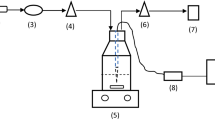Abstract
Dissolved H2 and CO2 were measured by an improved manual headspace-gas chromatographic method during fermentative H2 production with N2 sparging. Sparging increased the yield from 1.3 to 1.8 mol H2/mol glucose converted, although H2 and CO2 were still supersaturated regardless of sparging. The common assumption that sparging increases the H2 yield because of lower dissolved H2 concentrations may be incorrect, because H2 was not lowered into the range necessary to affect the relevant enzymes. More likely, N2 sparging decreased the rate of H2 consumption via lower substrate concentrations.
Similar content being viewed by others
References
Angenent LT, Karim K, Al-Dahhan MH et al (2004) Production of bioenergy and biochemicals from industrial and agricultural wastewater. Trends Biotechnol 22(9):477–485
Batstone DJ, Keller J, Angelidaki I et al (2002) Anaerobic digestion model No. 1 (ADM1). IWA Publishing, London
Chapelle FH, Vroblesky DA, Woodward JE et al (1997) Practical considerations for measuring hydrogen concentrations in groundwater. Environ Sci Technol 31(10):2873–2877
Fang Y, Hozalski RM, Clapp LW et al (2002) Passive dissolution of hydrogen gas into groundwater using hollow-fiber membranes. Water Res 36(14):3533–3542
Frigon JC, Guiot SR (1995) Impact of liquid-to-gas hydrogen mass transfer on substrate conversion efficiency of an upflow anaerobic sludge bed and filter reactor. Enzyme Microbial Technol 17(12):1080–1086
Hussy I, Hawkes FR, Dinsdale R et al (2003) Continuous fermentative hydrogen production from a wheat starch co-product by mixed microflora. Biotechnol Bioeng 84(6):619–626
Hussy I, Hawkes FR, Dinsdale R et al (2005) Continuous fermentative hydrogen production from sucrose and sugarbeet. Int J Hydrogen Energy 30(5):471–483
Kim DH, Han SK, Kim SH et al (2006) Effect of gas sparging on continuous fermentative hydrogen production. Int J Hydrogen Energy (in press). DOI 10.1016/j.ijhydene.2006.02.012
Kolb B, Ettre LS (1997) Static headspace-gas chromatography. Wiley-VCH, New York
Kraemer JT, Bagley DM (2005) Continuous fermentative hydrogen production using a two-phase reactor system with recycle. Environ Sci Technol 39(10):3819–3825
Lamed RJ, Lobos JH, Su TM (1988) Effects of stirring and hydrogen on fermentation products of Clostridium thermocellum. Appl Environ Microbiol 54(5):1216–1221
Madigan MT, Martinko JM, Parker J (2000) Brock biology of microorganisms, 9th edn. Prentice Hall, New Jersey
Mizuno O, Dinsdale R, Hawkes FR et al (2000) Enhancement of hydrogen production from glucose by nitrogen gas sparging. Bioresour Technol 73(1):59–65
Oh S-E, Van Ginkel S, Logan BE (2003) The relative effectiveness of pH control and heat treatment for enhancing biohydrogen gas production. Environ Sci Technol 37(22):5186–5190
Park W, Hyun SH, Oh S-E et al (2005) Removal of headspace CO2 increases biological hydrogen production. Environ Sci Technol 39(12):4416–4420
Pauss A, Andre G, Perrier M et al (1990) Liquid-to-gas mass transfer in anaerobic processes: inevitable transfer limitations of methane and hydrogen in the biomethanation process. Appl Environ Microbiol 56(6):1636–1644
Pauss A, Guiot SR (1993) Hydrogen monitoring in anaerobic sludge bed reactors at various hydraulic regimes and loading rates. Water Environ Res 65(3):276–280
Robinson JA, Strayer RF, Tiedje JM (1981) Method for measuring dissolved hydrogen in anaerobic ecosystems: application to the rumen. Appl Environ Microbiol 41(2):545–548
Stumm W, Morgan JJ (1996) Aquatic chemistry, 3rd edn. Wiley, New York
Tanji KK, Gao S, Scardaci SC et al (2003) Characterizing redox status of paddy soils with incorporated rice straw. Geoderma 114(3–4):333–353
Thauer RK, Jungermann K, Decker K (1977) Energy conservation in chemotrophic anaerobic bacteria. Bacteriol Rev 41(1):100–180
Wood HG, Ragsdale SW, Pezacka E (1986) The acetyl-CoA pathway of autotrophic growth. FEMS Microbiol Rev 39(4):345–362
Acknowledgements
This research was supported in part by the Centre for Research in Earth and Space Technology (CRESTech), the William H. Doherty Ontario Graduate Scholarship in Science & Technology, and the Natural Sciences and Engineering Research Council (NSERC) of Canada.
Author information
Authors and Affiliations
Corresponding author
Rights and permissions
About this article
Cite this article
Kraemer, J.T., Bagley, D.M. Supersaturation of Dissolved H2 and CO2 During Fermentative Hydrogen Production with N2 Sparging. Biotechnol Lett 28, 1485–1491 (2006). https://doi.org/10.1007/s10529-006-9114-7
Received:
Accepted:
Published:
Issue Date:
DOI: https://doi.org/10.1007/s10529-006-9114-7




